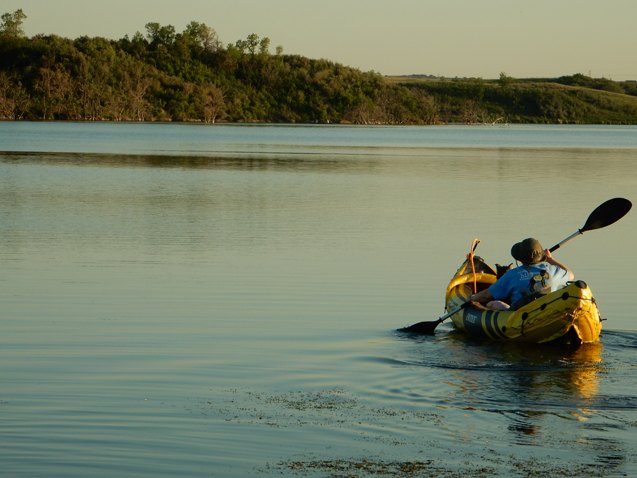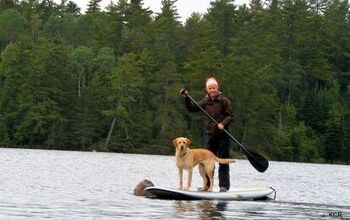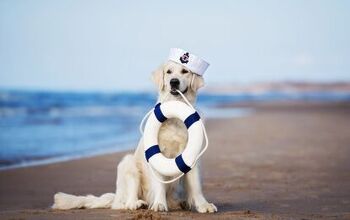Doggy Paddling: How to Kayak With Your Dog

Kayaking is experiencing a surge in popularity among dog owners, and for good reason. For the solitary day-tripper, a kayak is a great excuse to get out on the water with your dog.
Where to Get Started
There are hundreds of different designs of kayaks to choose from. This can be overwhelming, but with a little research, you’ll find the right boat for you and your dog.
First, you need to consider your needs. Kayaks are broken down into different styles, depending on the style of boating they are meant for. But if you want a watercraft that’s dog-friendly, choose from Recreational Kayaks or Sit-On-Top Kayaks.
Related: 5 Reasons to Consider Canoeing With Your Canine
Recreational kayaks are a great choice for dog paddlers. They are stable boats that are mainly enclosed, except for the cockpit. Recreational kayaks are perfect for people with dogs small enough to fit on their laps. Some of these kayaks have dry storage areas with removable lids. These may be suitable for medium-sized dogs to sit in while you paddle.
Some recreational kayaks come with an extra seat – these are called tandem kayaks, and your medium to large dog may need his own spot. In many cases, the seats can also be removed creating an open area where your dog can get comfortable. Consider putting down a yoga mat or similar non-slip surface to give your dog the secure footing that they need to feel both safe and comfortable.
Sit-on-top kayaks are also stable, and are the easiest kayaks to get into (my grandmother was still getting into one well into her 80s). A sit-on-top kayak is completely open, so there are plenty of options on where your dog can sit. Some sit-on-top kayaks are inflatable. These are not suitable for windy conditions but are a good choice for people with little room for storage.
Just like the recreational kayaks, you can use a yoga mat to create a pet-friendly space. Not only will this offer a comfortable area for your dog, but it will also add a layer of protection against your dog’s nails when using an inflatable kayak.
The two other types of kayaks are sea kayaks and white water kayaks. Both of these are unsuitable for dogs.
Sea kayaks are long, with pointed ends, and they tend to be narrow and long. Not the most ideal kayak for most dog owners, as they don’t leave much room for your dog to hang out.
White water kayaks are much smaller and rounder than a sea kayak. They are designed to be a really tight fit for the user, so you can steer with your whole body, and when you flip, you can roll right back up. A white water boat is not suitable for dog owners because there’s simply no room! These boats are sensitive to maneuvering, meaning the slightest lean or change will change your course. Not a good plan with a dog.
I know that the hard-core adventure seekers are out there right now being all like, “Dude, I totally want to bring my dog some Class III rapids!” If you think your pup would love to accompany you down a series of rapids, think again. Being flipped out of a boat can be scary and disorientating! Turned upside down, and then dunked into the water, your dog struggles for the surface. Reaching the surface, his first thought is to head for shore. Can he read the rapids and steer a safe course for shore? Sorry to harsh your mellow dude, but no matter your paddling skills, you are likely to bail at some point. Don’t subject your dog to that.
Where to Find a Boat
I suggest that you first head to a local outfitter that rents kayaks. You can check out a few models over the season and pick the one that is best for you and your dog. Tell them upfront that you are in the market for a kayak that you can paddle with your dog. Many outfitters are dog lovers too and will be able to steer you to a specific model of kayak that is suitable for you and your dog.
Another solution is to reach out to other dog-friendly paddlers in your community or in online groups like those on Facebook. Try joining groups that are specifically geared to dog owners that enjoy paddling or adventuring with their dogs. You may find a great deal on a kayak that someone else has outgrown or upgraded from while also gathering advice and recommendations from other kayakers that bring their dogs along on their trips.
Doggy Style
Each dog is different. Some of my dogs have hated the kayak because they were too big to fit into it, or they loved riding way up on the bow as I paddled along. Your dog’s personality is going to play a big part in their riding style. A cuddly dog is going to want to be down right in the cockpit with you; a feisty dog who likes to look out on the world may be happier riding the bow. And keep in mind, size does matter – a larger dog is going to need a kayak that will meet his physical needs.
If you have a dog that adores swimming, they may not be interested in traveling on the water without jumping in. If you do decide to give it a try, be prepared for the fact that your dog may flip the kayak while diving in, taking you both for a swim whether you like it or not!
Getting Your Dog Onboard
Some dogs take to kayaking like a duck to water, others… well, not so much. The idea here is to have fun and ensure that your dog will kayaking with you for many years to come. Don’t rush it. Head out with a dog who has been well exercised and has done their business before getting on the boat. There’s nothing worse than a dog stuck in a kayak who has to pee!
Before getting into the water, practice getting into and out of the boat on land – that goes for the both of you! People often focus on training their dog to get in the boat, but forget that you both have to get in at some point. Have your dog practice getting in the boat and laying down. Make it a total treat party, you want your dog’s experiences with paddling to be positive.
Related: Stand Up Paddle Boarding With Your Dog
When your dog seems ready, do these same exercises in shallow, calm water. Again, pour on the treats! Start by standing next to the boat to keep it stable, and then get in the boat and ask your dog to join you. When you’re ready head out for a short paddle, bring those treats with you. Your maiden voyage is not going to be long, but you want it to be positive, so your dog gets back in the boat with you next time.
Don’t Tie Me Down!
If your dog needs to be on a leash to be in the boat, your dog isn’t ready to be out on the water. Brush up on the obedience skills and try again in a few weeks. You’re going to see birds, boats, waves and all sorts of interesting things. Will your dog stay put, or will he take a plunge? If you aren’t certain, then you aren’t ready. Many a kayaking newbie puts a leash on their dog, or even worse, ties their dog to the boat! If you flip, your dog is trapped, or the leash can get caught around limbs, yours or theirs. Keep the leash close by, but never attached to the dog.
My paddling leashes all fit nicely into their own little pockets. When I need them, I just clip them on the dog, and the leash pulls out of the pocket. If we flip, the leashes stay in their pockets and aren’t a hazard to anyone.
Sun Safety
The water reflects harmful UV rays back up at you and your dog. In addition to being baked from above, you’ll be slow-roasted from below, too. You wear sunscreen and protect yourself from the sun’s harmful rays, and your dog needs you to take their needs into consideration. Paddle early in the morning, when the rays of the sun are less powerful. I don’t recommend you paddle later in the evening until you are both practiced paddlers. Should something go wrong while you are out on the water, a daytime rescue is going to be far more likely.
If your dog has a very short coat, you may want to consider using a dog-friendly sunscreen product to keep them from experiencing a painful or uncomfortable burn. Another product that some dog owners consider is the use of dog goggles with UV protection. These work much like sunglasses, protecting your dog’s eyes from the sun’s rays. They are uniquely designed to fit and stay securely on a dog’s head throughout the day regardless of what adventures you may go on.
Ensure your dog has plenty to drink, and don’t encourage leaning over the boat to slurp up some water. Not all water sources are safe to drink, and a dog leaning over at the wrong time can really upset your boat.
High Visibility
When preparing for your trip, take the color of your dog’s collar or harness into consideration. If you do run into trouble or the kayak tips and your dog is swimming back to shore, a bright color will make your dog more visible in the water. This will help others spot your pup during a rescue. If you know that you are going to be out later in the evening, choose a collar or harness with a reflective strip. This will really stand out and shine when a flashlight or headlight on a boat comes across your dog, aiding in the event of a night rescue (which is already difficult enough, to begin with).
PFD or not to PFD
Some dogs need a lifejacket. Dogs who aren’t strong swimmers or dogs who are strong sinkers will need a PDF. Elderly dogs who tire faster or feel the cold of the water are great candidates for a doggy life jacket.
If you aren’t sure of your dog’s swimming ability, find out before you paddle out into the water!
There are no dog lifejackets on the market that have been tested or approved by the Coast Guard. It’s a buyer-beware market. Most of the lifejackets for dogs are designed to aid in buoyancy. They will not keep your dog’s head above water if your dog is unconscious. They will help your dog save energy on a long swim to shore. An added bonus of a lifejacket with a strap on the back is if your dog does end up in the water, you may be able to use the strap to help pull them back into the boat.
Keep in mind that not all dog lifejackets are made the same. Some are thicker and designed to offer the highest level of buoyancy for your dog. These are great for dogs that are the least comfortable swimming back unaided. But they may be frustrating for dogs that are more agile in and around the water as they can be bulky. For dogs that are more comfortable in the water, but still need a little assistance, there are PFDs that offer a narrower lightweight design. They aren’t as strong in terms of buoyancy, but they do offer some support when needed.
Let me know if you have any more questions I haven’t answered in the comment section below. I love converting other dog owners to my passion!

Kevin Roberts lives for adventure. Together with his pack of rescue dogs and his husband, he spends as much time outdoors as possible. Kevin lives by the motto: "Get outside and play with your dogs!
More by Kevin Roberts


























